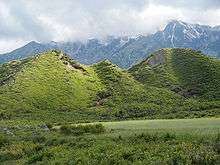Labëria
Labëria is a historic region that is roughly situated in Southern Albania. Its inhabitants are known as Labs (referred to as Albanian: sing: Lab, pl. Lebër, also dial. sing.: Lap in Albanian and Greek: Λιάπης, Liapis in Greek) and its boundaries reach from Vlorë to Himara in the south, to the Greek border near Sarandë, incorporating the Kurvelesh region of Gjirokastër District and extending east to the city of Tepelenë.

Labëria is culturally distinguishable from the rest of Albania in its traditions and folklore. The Labs were warlike pastoral people who lived mainly in the mountains of Kurvelesh, Progonat and Vlorë during the Ottoman invasion of Albania. However, due to mass migrations to urban areas following World War II, the population is now concentrated in the cities of Vlorë, Tepelenë, Gjirokastër and Sarandë.
Historically the Labs were followers of the Eastern Orthodox Christianity but many converted to Islam during Ottomon rule, with the bulk of conversion occurring in the 18th century. Conversions were especially intense during years of conflict between Orthodox Russia and the Ottoman Empire, during which some pressure was applied on Orthodox Christians by Ottoman rulers, including even low-scale forced conversion of villages, contradicting the official Ottoman tolerance for Christians.[1] Additional reasons for conversion included discrimination and exploitation of Christians by Ottoman rulers, the previous patterns of conversion between different Christian sects and the diverse pre-Ottoman distribution of Christian faiths in the region (including Orthodoxy, Catholicism, Bogomolism and even Arianism), the poll tax which only Christians had to pay, the poverty of the church, the mass illiteracy of priests and the fact that the language of worship was not the Albanian vernacular.[1][2] Tradition holds that a mass conversion of Labs occurred during a famine in which the bishops of Himara and Delvina refused to let the Labs break fast and drink milk.[3]
Many Labs were recruited by the Ottoman Jannissary corps due to their warlike nature and the Ottomans' initial preference for recruiting Albanians after their invasion of the Balkans. After the disbandment of the Jannissary corps by Sultan Mahmud II in 1826, the Sufi branch of the Bektashi Order, a core Janissary institution, was also disbanded, and its followers executed or exiled to Southern Albania. As a result, the majority of the Labs today belong to the Bektashi faith with Orthodox Christians concentrated in the Himara coastal region as well as a few pockets throughout Vlore district and the southern and eastern parts of the region, around Gjirokastër, Delvine and Sarande.
Labëria's most famous son is Ali Pasha of Tepelena or of Yanina (Ioannina), surnamed Aslan, "the Lion", or the "Lion of Yannina" (1740–1822), who ruled the western part of Rumelia, the Ottoman Empire's European territory which was also called Pashalik of Yanina. His court was in Ioannina. Ali had three sons: Ahmet Muhtar Pasha (served in the 1809 war against the Russians), Veli Pasha of Morea and Salih Pasha of Vlore. Ali Pasha of Tepelena died fighting on February 5, 1822, at the age of 82.
See also
- Pleqërishte, genre of Albanian iso-polyphony primarily found in Labëria
- Albanian Riviera
- Shushica River
Coordinates: 40°10′N 19°50′E / 40.167°N 19.833°E